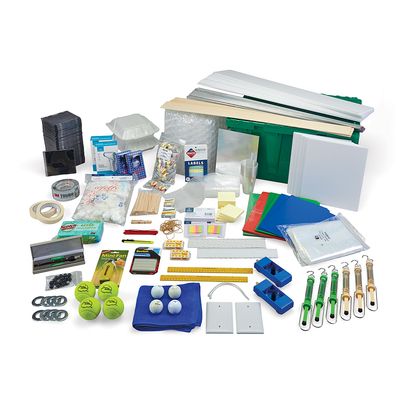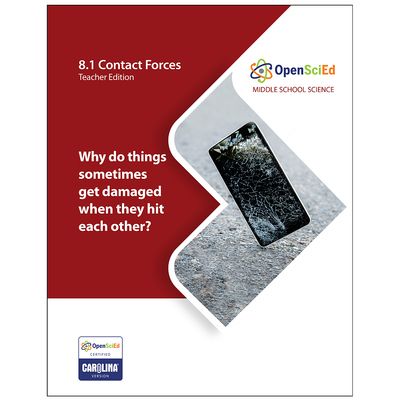Description
For additional program information and pricing, complete this form or contact your sales representative.
Grades 6–8. In Unit 8.1 Contact Forces, Carolina Certified Version*, students work to answer the Unit Driving Question: "Why do things sometimes get damaged when they hit each other?"
The unit begins as students consider situations in which they have seen their phones break. They contrast these situations with others where something else collided with another object and either did break or, surprisingly, did not. Students then attempt to identify the factors that contribute to damage occurring in some collisions but not others, and try to explain what is happening during the collision that causes one type of result versus another�all of which sparks a series of questions and ideas for investigations around the question, "Why do things sometimes get damaged when they hit each other?" This drives the work for the first two parts of the unit.
In the first part of the unit, students make general observations about what happens to objects during collisions and quickly move to analyzing data that show objects deform when forces are applied. This leads students to:
- Plan and carry out investigations and analyze and interpret data to figure out that all solid objects behave elastically up to a point and that the forces between objects in a collision are always equal in size and opposite in direction.
- Develop and use free body diagram models to represent the changes in the relative strength of forces on different objects in a collision.
- Create and use mathematical models to determine how changes in the mass and speed of an object affect the amount of kinetic energy that object has.
- Develop and use system models to support explanations for how contact forces, including friction and air resistance, cause energy to be transferred from one part of the system to another before, during, and after a collision.
In the second part of the unit, students design solutions to protect an object of their choice in a collision. They gather design input from stakeholders to refine the criteria and constraints for their design solution, and the class works together to carry out a series of investigations to answer the questions they have about optimizing their design solutions. This leads students to:
- Plan and carry out investigations to determine which cushioning materials reduce peak forces the most in a collision.
- Develop macroscopic models of small and microscopic structures of these materials and use these to generate data about how space to deform, contact time in a collision, and peak forces in a collision are related.
- Carry out investigations and analyze data about how the shape and size of cushioning materials affect force distribution in a cushioning structure.
- Identify trade-offs, analyze and critique design solutions, and optimize design solutions using evidence from these investigations to solve different design problems for different stakeholders and different contexts.
The final part of the unit re-anchors around a related question and a design problem to figure out what kinds of solutions students can design to protect fragile things from breaking.
This 1-Class Unit Kit includes basic teacher access to instructional materials on CarolinaScienceOnline.com, plus the materials needed to teach 1 class of 32 students per day.
Building Toward NGSS Performance Expectations
- MS-PS2-1: Apply Newton's third law to design a solution to a problem involving the motion of two colliding objects.
- MS-PS2-2: Plan an investigation to provide evidence that the change in an object's motion depends on the sum of the forces on the object and the mass of the object.
- MS-PS3-1: Construct and interpret graphical displays of data to describe the relationships of kinetic energy to the mass of an object and to the speed of an object.
- MS-LS1-8: Gather and synthesize information that sensory receptors respond to stimuli by sending messages to the brain for immediate behavior or storage as memories.
- MS-ETS1-2: Evaluate competing design solutions using a systematic process to determine how well they meet the criteria and constraints of the problem.
- MS-ETS1-3: Analyze data from tests to determine similarities and differences among several design solutions to identify the best characteristics of each that can be combined into a new solution to better meet the criteria for success.
Science and Engineering Practices
- Planning and Carrying Out Investigations
- Analyzing and Interpreting Data
- Constructing Explanations and Designing Solutions
- Engaging in Argument from Evidence
Focal Disciplinary Core Ideas
- PS2.A
- PS3.A
- ETS1.B
- EST1.C
- LS1.D
Focal Crosscutting Concepts
- Systems and System Models
- Matter and Energy
- Structure and Function
- Stability and Change
*All enhancements to materials and instruction for this Carolina Certified Version of the unit are approved by OpenSciEd to preserve the integrity of the storyline and the instructional model.
Specifications
- Shipping Information or Purchase Restrictions
-
- Contact us for program details and pricing. Call 800.334.5551.
- What’s Included:
-
- Unit Technology Pack (basic digital access to teacher's guide and all instructional resources for the teacher)
- Aluminum Strips
- Bags, Plastic, Resealable, 9 x 12"
- Balls, Golf
- Balls, Tennis
- Balsa Sheets
- Blank Electrical Plates
- Clothes Pin, Wooden
- Cups, Plastic, 10 oz
- Dynamics Carts
- Fans, Personal, Battery-Operated
- File Folders, Plastic
- Foamboards, 6 x 36"
- Foamboards, 10 x 12"
- Force Meters/Spring Balances, 1 kg
- Force Meters/Spring Balances, 500 g
- Knife, Retractable
- Laser Pointer
- Marbles
- Mini Index Flags
- Mirror, Plastic, 8 x 10"
- Plasticine Clay
- Putty, Adhesive
- Rulers, Plastic, Metric (12")
- Sponges
- Terry Cloth Towels
- Thermometers, Infrared
- Timers
- Ultra-Velcro®, Hook
- Ultra-Velcro®, Loop
- Washers, Flat, Zinc
- Batteries, Alkaline, AA
- Batteries, Alkaline, AAA
- Bubble Wrap, Large
- Bubble Wrap, Small
- CD Cases
- Coffee Stirrers, Wood
- Containers, Styrofoam® Takeaway Food
- Cotton Balls
- Ear Plugs
- Note Cards, White
- Note Pads, Self-Adhesive, Medium
- Paper, Construction, Green
- Paper, Construction, Red
- Rubber Bands
- Sticker Dots
- Tape, Duct
- Tape, Masking
- Twist Ties
expand to see full list - Needed But Not Included:
-
- Books, Hardbound
- 1 Box
- 16 Bricks
- 1 Buret Clamp
- 8 Calculators
- 1 Cardboard
- 1 Cart, Rolling
- 8 Colored Pencil Sets
- 2 Erasers
- 32 Goggles, Impact-Resistant
- Markers
- 2 Meter Stick
- Paper Towels
- 1 Paper, Blank, 8-1/2 x 11"
- 50 Paper, Scrap, Sheets
- Rice Noodles, Wide
- 1 Ring Stand
- 1 Rock, 5–7 cm
- 1 Scale, Electronic
- 1 Scissors
expand to see full list - Return Policy:
-
If for any reason you are not satisfied with this item, it is eligible for a return, exchange, refund, or credit up to 180 days from date of purchase. Restrictions may apply. Returns & Exchanges Policy.

